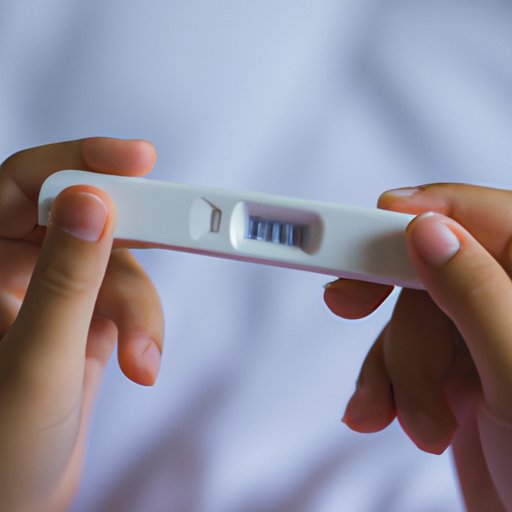
Introduction
Detecting pregnancy can be an exciting, nerve-wracking time for many people. Whether you’ve been trying to conceive or are experiencing unexpected symptoms, it’s important to know what signs to look out for and when to take a pregnancy test. In this article, we’ll explore the different ways to tell if you’re pregnant and discuss the next steps to take after finding out.
Signs and Symptoms of Pregnancy: A Comprehensive Guide
There are several different signs and symptoms that can indicate pregnancy. While some are more widely known, others may be lesser-known but just as common. The most common signs of pregnancy include:
- Missed period
- Nausea and vomiting
- Breast tenderness and swelling
- Increased fatigue
- Frequent urination
- Food aversions or cravings
In addition to these common symptoms, there are others that may not be as well-known. These include:
- Spotting or cramping
- Constipation
- Dizziness or lightheadedness
- Acne or skin changes
- Changes in libido
- Heightened sense of smell
How to Know If You’re Pregnant: Early Indicators to Look Out For
The early stages of pregnancy can be the most challenging to detect, as symptoms may be subtle or easily confused with other conditions. However, there are a few key indicators to pay attention to if you suspect you may be pregnant. These include:
- Implantation bleeding or spotting
- Cramping or twinges in the lower abdomen
- Changes in cervical mucus
- Basal body temperature changes
- Early pregnancy tests
It’s also important to note that every person’s body is different, and not everyone will experience the same symptoms or at the same times. This is why keeping track of your body and being aware of any changes is crucial in detecting pregnancy early on.
The Science Behind Home Pregnancy Tests and How They Work
Home pregnancy tests have become a popular method of detecting pregnancy in recent decades. These tests work by detecting the presence of the hormone human chorionic gonadotropin (hCG) in a person’s urine. This hormone is produced by the developing placenta and is typically detectable in urine within two weeks of conception. Home pregnancy tests are designed to be highly sensitive and accurate, with the ability to detect very low levels of hCG in urine.
There are many different types of home pregnancy tests available on the market, including digital tests, early detection tests, and test strips. Digital tests typically provide a clear indication of whether or not a person is pregnant, while early detection tests can detect pregnancy up to six days before a missed period. Test strips are the most common type of home pregnancy test and are typically the most affordable as well.
When to Take a Pregnancy Test: Understanding the Accuracy and Timing of Results
Knowing when to take a pregnancy test can be tricky, as it depends largely on when a person ovulates and when hCG levels are detectable in urine. For the most accurate results, it’s usually best to wait until the first day of a missed period to take a test. However, some tests claim to be able to detect pregnancy several days before a missed period. It’s important to note that the accuracy of these tests can vary and may result in false negatives or false positives if taken too early.
Factors such as the time of day, the amount of fluids consumed, and certain medications can also affect the accuracy of home pregnancy tests. It’s recommended to take the test first thing in the morning before consuming any fluids for the most accurate results.
Exploring the Different Stages of Pregnancy: From Conception to Delivery
Pregnancy is divided into three trimesters, each with its own unique developments and challenges. During the first trimester, the fertilized egg implants in the uterus and begins to develop into an embryo. During the second trimester, the baby grows and begins to move around more, and the pregnant person may experience more pronounced symptoms. The third trimester brings the baby closer to delivery, with the potential for labor to begin at any time. Important milestones include the baby’s first movements, the ability to hear the baby’s heartbeat, and ultrasound imaging to monitor growth.
Common Misconceptions About Detecting Pregnancy
There are many myths and misconceptions surrounding pregnancy detection. One common myth is that a negative pregnancy test means you’re definitely not pregnant. However, it’s possible for hCG levels to be too low to detect in the early stages of pregnancy. Another myth is that you can only get pregnant during ovulation. In reality, sperm can survive in the body for several days and may result in pregnancy even if intercourse doesn’t occur during ovulation. It’s important to be aware of these common misconceptions to avoid false positives or negatives when trying to detect pregnancy.
What to Do After You Find Out You’re Pregnant: Next Steps and Important Considerations
Once you’ve confirmed that you’re pregnant, it’s important to begin prenatal care as soon as possible. This typically involves regular visits with a healthcare provider to monitor the baby’s growth and development, as well as the pregnant person’s health. Other important considerations include adjusting your diet and exercise routines, getting enough rest, and preparing for childbirth and newborn care. There are also many resources available for expecting parents, such as childbirth classes, breastfeeding support, and mental health services.
Conclusion
Detecting pregnancy can be an exciting and sometimes nerve-wracking time, but knowing what signs to look out for and when to take a pregnancy test can help ease concerns. It’s important to pay attention to your body and seek medical care as soon as possible after confirming pregnancy. By staying informed and taking proactive steps, you can ensure a healthy pregnancy and a healthy baby.




